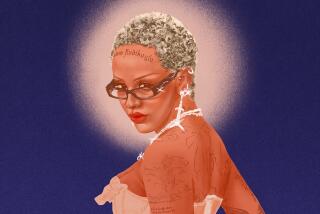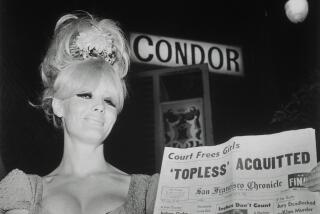Certain women in ‘Tap’ raise the bar high
- Share via
A short-haired woman tapping lightly, deftly to a spare, uninsistent arrangement of a vintage pop ballad while dressed in a shapeless top (usually glittery) over pants and flat shoes. That image, that performance mode, that costume linked soloist after soloist on the “Women in Tap” program in Glorya Kaufman Hall at UCLA on Saturday, the climax to an ambitious three-day conference primarily focused on celebrating the minimalist jazz-tap of the 1970s.
Although the 14-dancer cavalcade included a few ambassadors from other tap traditions, many of the women on the program helped rescue tap from show-biz excesses 30 years ago, refining it as a concert-dance form -- indeed, soon arguably over-refining it until it offered little more than ultra-discreet revelations of personality and resolutely emotionless explorations of musical minutiae. Fascinatin’ rhythm? More like a feeble pulse at UCLA, with a few glorious exceptions.
Besides daring to wear something curvier than the prevailing unisex uniform, Deborah Mitchell moved brilliantly in a rich, unpredictable and disarmingly slinky style throughout her tribute to her tap mentor, Leslie “Bubba” Gaines. A born storyteller, Mitchell spoke feelingly of the transmission of tap from veteran to novice, generation after generation, and we all became her rapt pupils.
In “My Mind’s on Mingus,” jazz-tap pioneer Brenda Bufalino brought a welcome dose of conceptual rigor to the proceedings as well as genuine jazz music rather than the elevator jazz chosen by too many of her colleagues. Yes, the four-member Jazz Tap Ensemble band, led by Jerry Kalaf, played the hand-me-down tunes skillfully. But without a powerful, individual musical impetus, jazz-tap never gets beyond the wan expertise that settled over Kaufman Hall like smog.
All hail, then, to Michelle Dorrance for cutting through the murk by tapping without music in darkness and reminding us of what’s essential in this art. And to Josette Wiggan for her take-no-prisoners attacks even at maximum complexity, a way of dancing informed by contemporary black culture. And to Chloe Arnold for her indomitably feisty tap adaptation of a Maya Angelou poem.
Together, Dorrance, Wiggan and Arnold tore the place apart with their unscheduled trio, the only group work on the program apart from an uneventful full-cast finale. Based on challenge dancing -- the original format for tap virtuosity -- it featured them trading and ornamenting steps with joyous vehemence, inspired by their interplay and so much in the moment that they made all the planned routines look like relics of a wrong turn in tap history.
Dormeshia Sumbry Edwards brought something of their passion and spontaneity to the final solo on the program, excelling in deliberately rough-edged footwork at maximum velocity: another tap artist who belongs to this new century whatever her debt to the past.
For tap students, historians and other conference attendees, the rest of the concert supplied nostalgic pleasures that may have seemed more essential than they did to this outsider. Certainly, Miriam Nelson provided a sweet souvenir of pre-jazz-tap song-and-dance showmanship, and the supremely gracious Dianne Walker skated over “Autumn Leaves” with suave delicacy.
Among the just-the-steps contingent, Linda Sohl-Ellson broke out of jazz-tap’s musical formulas with her familiar, collaborative “Espiritu” while Terry Brock aimed for a perky profile with “Lady Be Good,” Heather Cornell for something more laid-back through her interplay with pianist Doug Walter, and Barbara Duffy (“Soldiers’ Hymn”) and Acia Gray “ (“Twos and Threes”) for stark, intricate display dancing.
Conference organizer Lynn Dally also performed, singing (sort of) “You Gotta Move,” though that imperative -- that need -- was hard to find in her solo and those of so many others on the program.
--
More to Read
The biggest entertainment stories
Get our big stories about Hollywood, film, television, music, arts, culture and more right in your inbox as soon as they publish.
You may occasionally receive promotional content from the Los Angeles Times.










